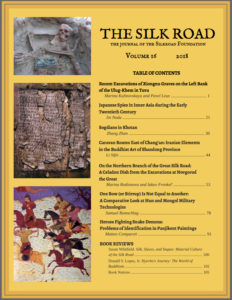It gives me great pleasure to introduce Volume 16 of The Silk Road. After more than fifteen years in the capable hands of longtime editor Daniel C. Waugh, The Silk Road baton has now passed into my hands. Much like parenthood, the responsibility of managing an annual journal is equal parts both blessing and burden, the latter marked by daily anxieties so consuming as to occasionally disrupt one’s evening slumber. Then come the minor triumphs that remind us why we got into this business in the first place: the production of fresh knowledge and dissemination of exciting new discoveries derived from the lands and peoples who continue to animate the historical rubric of the Silk Road.

The latest volume of The Silk Road fully lives up to this promise. Our excursion through place and time begins with a fascinating archaeological report by Marina Kulinovskaya and Pavel Leus on recently excavated Xiongnu graves in Tuva, lavishly illustrated with nearly fifty color photographs from the field. We are then treated to Jin Noda’s analysis of Japanese intelligence agents in Russian and Qing Inner Asia during the late nineteenth and early twentieth centuries. Next up is Zhang Zhan’s in-depth reassessment of ancient Sogdian documents from Khotan and what they can tell us about the status and occupations of these far-flung travelers during the first millennium CE. Zhang’s philological analysis is followed by Li Sifei’s investigation into the complex subject of Chinese perceptions of “Persians” and “Sogdians” during the Northern Zhou, Sui, and Tang dynasties. Marina Rodionova and Iakov Frenkel’ then encourage us to transfer our attention to the other, far less popularized end of the Silk Road, with a detailed case study of how a Mongol-era Chinese celadon made its way to the Novgorod Kremlin in Russia. Continue reading →


